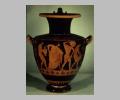Introduction
On a red-figure hydria now in Munich (
Munich 2421;
FR, pl. 71, 1)
1 we see one of the first depictions of a subject which subsequently becomes more popular in Attic vase-painting, the music lesson. This one is typical in showing a seated youth, plektron in hand, strumming his lyre. Before him an older man, sitting on a klismos (chair) instead of a diphros (stool), holds the strings of his instrument still. Two onlookers, a draped youth, enveloped in his himation, and an older man leaning on his walking stick stand nearby. What makes this scene unusual is that its painter, Phintias, has labeled the music student Euthymides, the name of his younger colleague in the ceramics business. Such camaraderie is characteristic of the group of vase-painters whom Beazley dubbed the "Pioneers" because they were the first to realize the potential of the new red-figure technique invented ca. 530-520 B.C. They appear to have been a close-knit group, naming each other on their vases and rivaling one another in their attempts to depict naturalistic bodies in challenging poses.
If we glance up to the shoulder of this vase (
), we see two half-draped hetairai, lounging on striped pillows and playing the drinking game kottabos, in which they flip the dregs of their wine toward an invisible target at the left. Out of the lips of the first hetaira, who turns around to address her comrade, comes a salute to Euthymides by means of the letters placed near her mouth:
ΣΟΙΤΕΝΔΙ ΕΥΘΥΜΙΔΕΙ. The implication of this remark is probably that she desires to be loved by the handsome youth. The somewhat awkward depiction of the breasts of the two women (
,
) shows how Phintias was struggling with the problem of foreshortening. In this particular detail, however, he was more successful than his fellow-Pioneer Euphronios who painted a similar scene on a psykter now in St. Petersburg (
St. Petersburg B. 1650).
The Munich hydria belongs to the developed stage of Phintias' career as a vase-painter (ca. 510 B.C.), along with a similar vase in London signed by the artist (
London E 159;
).
2 Both vases group four figures on the central panel, three facing to the right, one left, and two reclining half-draped figures on the shoulder. On the shoulder of the London hydria, we find two male symposiasts, also lying against striped pillows (
), the older holding two kylixes, the younger a lyre. Below on the body panel are three nude boys hastening with their hydriai to the fountain house indicated by the lion-head waterspout at the far right, while an elder, draped man looks on. Scenes of water fetching are especially appropriate for water vessels, but as with the female revelers on the Munich hydria, Phintias has here reversed the traditional sex roles, for women are normally engaged in this activity. At this time (ca. 520-510 B.C.) there appeared a large number of late black-figure hydriai which show women at the fountain house, but this is one of the rare examples of males fetching water.
3 With their head wreaths, curly hair, long fingers and feet, they closely resemble the music student on the Munich vase. Likewise the framing ornament of black-figure dotted palmettes below and simple meander above is the same on both vases. However, note the more advanced red-figure palmettes at the sides of the London vase, indicating that it is marginally later than the Munich hydria. During this experimental phase, artists who were no doubt trained in the earlier technique, only gradually abandoned black-figure conventions in favor of red-figure.






